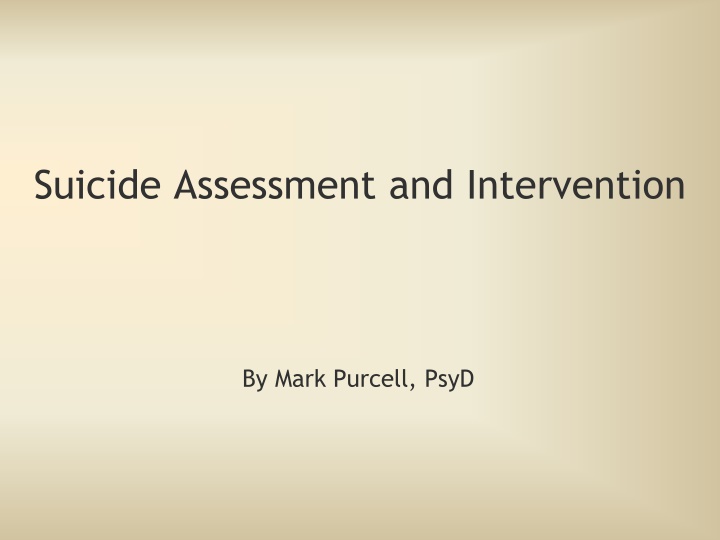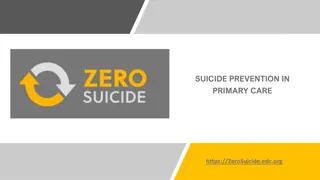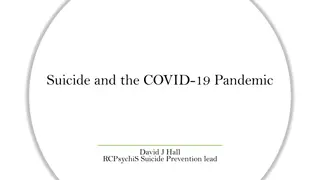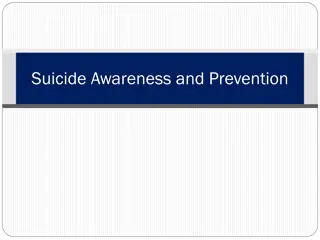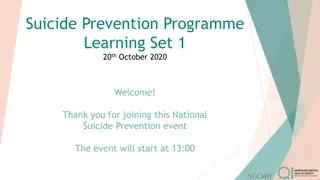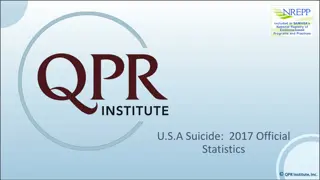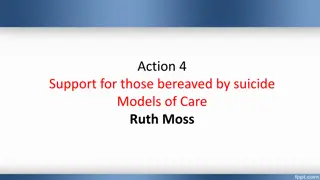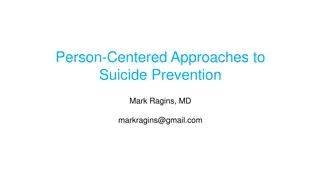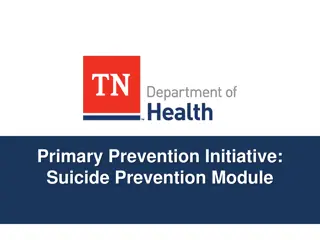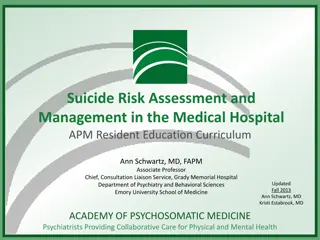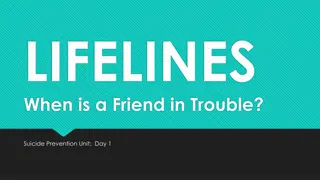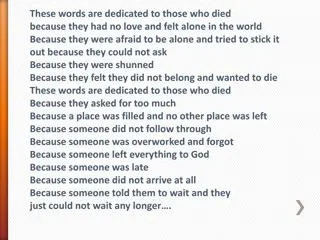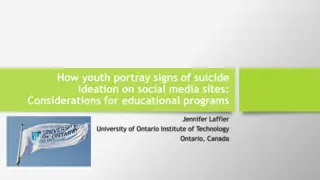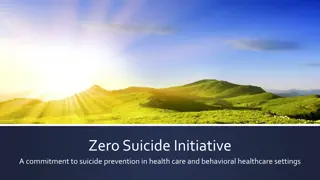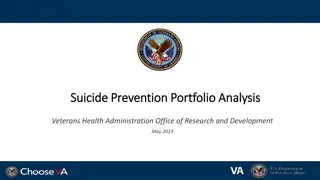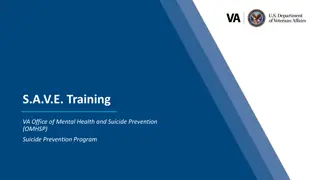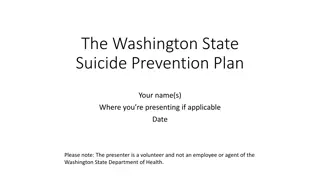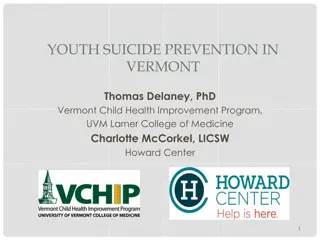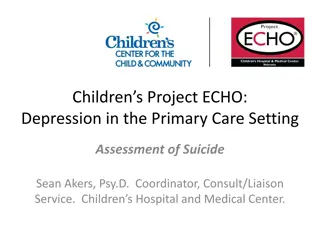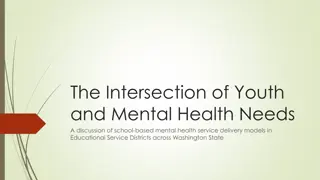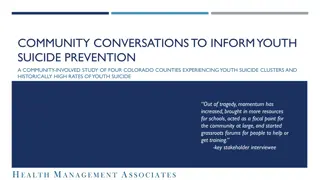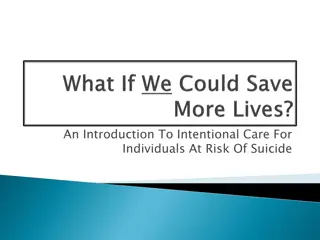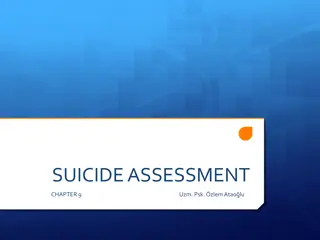Suicide: Assessment, Intervention, and Prevention
This resource provides valuable insights into suicide assessment, intervention, and prevention by discussing myths vs. facts, risk and protective factors, cultural competency, and statistics. It emphasizes the importance of recognizing suicide as a complex issue influenced by individual characteristics, societal factors, and the need for multidimensional approaches to support those at risk.
Download Presentation

Please find below an Image/Link to download the presentation.
The content on the website is provided AS IS for your information and personal use only. It may not be sold, licensed, or shared on other websites without obtaining consent from the author.If you encounter any issues during the download, it is possible that the publisher has removed the file from their server.
You are allowed to download the files provided on this website for personal or commercial use, subject to the condition that they are used lawfully. All files are the property of their respective owners.
The content on the website is provided AS IS for your information and personal use only. It may not be sold, licensed, or shared on other websites without obtaining consent from the author.
E N D
Presentation Transcript
Suicide Assessment and Intervention By Mark Purcell, PsyD
Training Sections 1. Myth versus Facts about Suicide 2. Risk and Protective Factors 3. Assessment and Intervention 4. Resiliency and Prevention 5. Cultural Competency 6. Statistics 7. Resources
Myth vs. Fact Clayton, J. Suicide Prevention: Saving Lives One Community at a Time. American Foundation for Suicide Prevention. http://www.afsp.org/files/Misc_//standardizedpresentation.ppt
Risk & Protective Factors
Defining the Problem Attempted suicide is a potentially self-injurious act committed with at least some intent to die as a result of the act.1 Suicide is an attempt to solve a problem of intense emotional pain with impaired problem-solving skills.2 Individuals of all races, creeds, incomes, and educational levels die by suicide. There is no typical suicide victim.3 1. Kalafat, J. & Underwood, M. Making Educators Partners in Suicide Prevention. Lifelines: A School-Based Youth Suicide Prevention Initiative. Society for the Prevention of Teen Suicide. http://spts.pldm.com/ 2. Kalafat, J. & Underwood, M. Making Educators Partners in Suicide Prevention. Lifelines: A School-Based Youth Suicide Prevention Initiative. Society for the Prevention of Teen Suicide. http://spts.pldm.com/ 3. Clayton, J. Suicide Prevention: Saving Lives One Community at a Time. American Foundation for Suicide Prevention. http://www.afsp.org/files/Misc_//standardizedpresentation.ppt
Characteristics of Suicide Alternative to problem perceived as unsolvable by any other means: Viewing suicide from this perspective has several important implications. For one, just as someone may get a temporary high from a drug, he or she may obtain temporary attention, support, or even popularity after a suicide attempt. A second implication of viewing suicide as an alternative is that suicide can then be understood as less than a wish to die than a wish to escape the intense emotional pain generate from what appears to be an inescapable solution. Kalafat, J. & Underwood, M. Making Educators Partners in Suicide Prevention. Lifelines: A School-Based Youth Suicide Prevention Initiative. Society for the Prevention of Teen Suicide. http://spts.pldm.com/
Characteristics of Suicide Person is often ambivalent: What this means is that the person is feeling two things at the same time: there is a part of that person that wants to die and part that wants to live and both parts must be acknowledged. While we line up with and unequivocally support the side that wants to live, this can t be done by ignoring or dismissing that side that wants to die. Kalafat, J. & Underwood, M. Making Educators Partners in Suicide Prevention. Lifelines: A School-Based Youth Suicide Prevention Initiative. Society for the Prevention of Teen Suicide. http://spts.pldm.com/
Characteristics of Suicide Suicidal solution has an irrational component: People who are suicidal are often unaware of the consequences of suicide that are obvious to the rest of the word. For example, they are usually not thinking about the impact of their death on others, or they hold a perception they will be reincarnated or somehow still present to see how others react to their deaths. This irrationality affects how trapped and helpless the person feels. Kalafat, J. & Underwood, M. Making Educators Partners in Suicide Prevention. Lifelines: A School-Based Youth Suicide Prevention Initiative. Society for the Prevention of Teen Suicide. http://spts.pldm.com/
Characteristics of Suicide Suicide is a form of communication: For people who are suicidal, normal communication has usually broken down and the suicide attempt may be the person s way of sending a message or reacting to the isolation they feel because their communication skills are ineffective. Kalafat, J. & Underwood, M. Making Educators Partners in Suicide Prevention. Lifelines: A School-Based Youth Suicide Prevention Initiative. Society for the Prevention of Teen Suicide. http://spts.pldm.com/
Death by Suicide and Psychiatric Diagnosis Psychological autopsy studies done in various countries from over almost 50 years report the same outcomes. - 90% of people who die by suicide are suffering from one or more psychiatric disorders: - Major Depressive Disorder - Bipolar Disorder, Depressive Phase - Alcohol or Substance Abuse - Schizophrenia - Personality Disorders such as Borderline Personality Disorder Clayton, J. Suicide Prevention: Saving Lives One Community at a Time. American Foundation for Suicide Prevention. http://www.afsp.org/files/Misc_//standardizedpresentation.ppt
Depression Four out of ten children and adolescents will have a second episode of depression within two years. Depressed adolescents are at an increased risk for substance abuse and pregnancy. Over half of depressed youth will attempt suicide, and at least 7% will ultimately die as a result. Early identification and treatment of depression can save lives. NAMI, 2005. Zenere, F. Youth Suicidal Behavior: Prevention and Intervention. Miami-Dade County Public Schools. http://www.helppromotehope.com/documents/Zenere_for_parents.pdf
Signs of Depression - Loss of interest in normal daily activities Feeling sad or down Feeling hopeless Crying spells for no apparent reason Problems sleeping Trouble focusing or concentrating Difficulty making decisions Unintentional weight gain or loss - - - - - - - Irritability Restlessness Being easily annoyed Feeling fatigued or weak Feeling worthless Loss of interest in sex Thoughts of suicide or suicidal behavior Unexplained physical problems, such as back pain or headaches - - - - - - - - When diagnosing depression, usually there must be a marked behavioral change lasting for two weeks or longer. Mayo Clinic (Feb 14, 2008). Depression: Symptoms. http://www.mayoclinic.com/health/depression/DS00175/DSECTION=symptoms
Signs of Depression in Youth Oversensitivity to criticism Risk-taking, hyperactivity Low self-esteem Indecision, withdrawal, inactivity Somatic symptoms and complaints Aggression, hostility Sleep disturbances Eating disorders Zenere, F. Youth Suicidal Behavior: Prevention and Intervention. Miami-Dade County Public Schools. http://www.helppromotehope.com/documents/Zenere_for_parents.pdf
Protective Factors for Suicide Protective factors reduce the likelihood of suicide; they enhance resilience and may serve to counterbalance risk factors. - Effective clinical care for mental, physical, and substance use disorders - Easy access to a variety of clinical interventions and support for help- seeking - Restricted access to highly lethal means of suicide - Strong connections to family and community support - Support through ongoing medical and mental health care relationships - Skills in problem solving, conflict resolution and nonviolent handling of disputes - Cultural and religious beliefs that discourage suicide and support self- preservation. Suicide Prevention Resource Center. Risk and Protective Factors for Suicide. http://www.sprc.org/library/srisk.pdf
Youth-Specific Protective Factors Contact with a caring adult Sense of connection or participation in school Positive self-esteem and coping skills Access to and care for mental/physical/substance disorders Kalafat, J. & Underwood, M. Making Educators Partners in Suicide Prevention. Lifelines: A School-Based Youth Suicide Prevention Initiative. Society for the Prevention of Teen Suicide. http://spts.pldm.com/
Risk Factors Risk factors may be thought of as leading to or being associated with suicide; that is, people possessing the risk factors are at greater potential for suicidal behavior. - Bio-psychosocial - Environmental - Socio-cultural Suicide Prevention Resource Center. Risk and Protective Factors for Suicide. http://www.sprc.org/library/srisk.pdf
Bio-psychosocial Risk Factors Mental disorders, particularly mood disorders, schizophrenia, anxiety disorders and certain personality disorders Alcohol and other substance use disorders Hopelessness Impulsive and/or aggressive tendencies History of trauma or abuse Some major physical illnesses Previous suicide attempt Family history of suicide Suicide Prevention Resource Center. Risk and Protective Factors for Suicide. http://www.sprc.org/library/srisk.pdf
Environmental Risk Factors Job, financial loss, drop out of school Homelessness Relational or social loss Easy access to lethal means Local clusters of suicides that have a contagious influence Suicide Prevention Resource Center. Risk and Protective Factors for Suicide. http://www.sprc.org/library/srisk.pdf
Socio-cultural Risk Factors Lack of social support and sense of isolation Stigma associated with help-seeking behavior Barriers to accessing health care, especially mental health and substance abuse treatment Certain cultural and religious beliefs (for instance, the belief that suicide is a noble resolution of a personal dilemma) Exposure to, including through the media, and influence of others who have died by suicide Suicide Prevention Resource Center. Risk and Protective Factors for Suicide. http://www.sprc.org/library/srisk.pdf
Youth-Specific Risk Factors Divorce or separation of parents Harassment by peers (bullying) Sexual identity crisis Gay, lesbian, bisexual or transgender sexual orientation Easy access to lethal methods, especially guns School crisis (disciplinary, academic) Genetic predisposition (serotonin depletion) Feelings of isolation or being cut off from others Ineffective coping mechanisms Inadequate problem-solving skills Cultural and/or religious beliefs (e.g., belief that suicide is a noble or acceptable solution to a personal dilemma) Exposure to suicide and/or family history of suicide Zenere, F. Youth Suicidal Behavior: Prevention and Intervention. Miami-Dade County Public Schools. http://www.helppromotehope.com/documents/Zenere_for_parents.pdf
Youth-Specific Risk Factors Influence (either through personal contact or media representations) of significant people who died by suicide Loss or separation (e.g., death, divorce, relationships) Exposure to violence Family crisis (e.g., abuse, domestic violence, running away, child-parental conflict Barriers to receiving mental health treatment; stigma, affordability, availability, accessibility Experiences of disappointment or rejection Feelings of stress brought about by perceived achievement needs Unwanted pregnancy, abortion Infection with HIV or other STDs Serious injury that may change life course (i.e., traumatic brain injury) Severe or physical terminal illness, or mental illness or substance abuse Zenere, F. Youth Suicidal Behavior: Prevention and Intervention. Miami-Dade County Public Schools. http://www.helppromotehope.com/documents/Zenere_for_parents.pdf
Warning Signs Threatening to hurt or kill oneself or talking about wanting to hurt or kill oneself Looking for ways to kill oneself by seeking access to firearms, pills, or other means Talking or writing about death, dying, or suicide when these actions are out of the ordinary for the person Feeling hopeless Feeling rage or uncontrolled anger or seeking revenge Acting reckless or engaging in risk activities seemingly without thinking National Suicide Prevention Lifeline. What are the warning signs for suicide? http://www.suicidepreventionlifeline.org/GetHelp/SuicideWarningSigns.aspx
Warning Signs Feeling trapped like there s no way out Increasing alcohol or drug use Withdrawing from friends, family, and society Feeling anxious, agitated or unable to sleep or sleeping all the time Experiencing dramatic mood swings Seeing no reason for living or having no purpose in life. National Suicide Prevention Lifeline. What are the warning signs for suicide? http://www.suicidepreventionlifeline.org/GetHelp/SuicideWarningSigns.aspx
Warning Signs for Youth Suicide Suicide threats Suicide plan/method/access Making final arrangements Sudden changes in physical habits and appearance Preoccupation with death and suicide themes Increased inability to concentrate or think clearly Loss of interest in previously pleasurable activities Symptoms of depression Increase use and abuse of alcohol and/or drugs Hopelessness Rage, anger, seeking revenge Zenere, F. Youth Suicidal Behavior: Prevention and Intervention. Miami-Dade County Public Schools. http://www.helppromotehope.com/documents/Zenere_for_parents.pdf
Warning Signs for Youth Suicide Reckless behavior or activities Feeling trapped Anxiety and agitation Sleep difficulties, especially insomnia Dramatic changes in mood Sudden/recent purchase of a weapon No reason for living No sense of purpose in life Sense of being a burden Profound sense of loneliness, alienation and isolation Sense of fearlessness Zenere, F. Youth Suicidal Behavior: Prevention and Intervention. Miami-Dade County Public Schools. http://www.helppromotehope.com/documents/Zenere_for_parents.pdf
Assessment and Intervention
Suicide Risk Assessment Five Step Evaluation 1. Identify Risk Factors 2. Identify Protective Factors 3. Conduct Suicide Inquiry 4. Determine Risk Level 5. Document
Intervention Three basic steps: 1. Show you care 2. Ask about suicide 3. Get help Clayton, J. Suicide Prevention: Saving Lives One Community at a Time. American Foundation for Suicide Prevention. http://www.afsp.org/files/Misc_//standardizedpresentation.ppt
Show You Care Take ALL talk of suicide seriously. If you are concerned that someone may take their life, trust your judgment. Listen carefully. Reflect what you hear. Use language appropriate for the age of the person involved. Clayton, J. Suicide Prevention: Saving Lives One Community at a Time. American Foundation for Suicide Prevention. http://www.afsp.org/files/Misc_//standardizedpresentation.ppt
Be Genuine Let the person know you really care!!! Talk about your feelings and ask about his or hers. Clayton, J. Suicide Prevention: Saving Lives One Community at a Time. American Foundation for Suicide Prevention. http://www.afsp.org/files/Misc_//standardizedpresentation.ppt
Ask About Suicide Don t hesitate to raise the subject. Be direct, but non-confrontational. Engage them: Are you thinking about suicide? What thoughts or plans do you have? Are you thinking about harming yourself, ending your life? How long have you been thinking about suicide? Have you thought about how you would do it? Do you have _____ (Insert means, weapon, etc.) Do you really want to die, or do you want the pain to go away? Clayton, J. Suicide Prevention: Saving Lives One Community at a Time. American Foundation for Suicide Prevention. http://www.afsp.org/files/Misc_//standardizedpresentation.ppt
Ask About Treatment Do you have a therapist/doctor? Are you seeing him/her? Are you taking your medications? Clayton, J. Suicide Prevention: Saving Lives One Community at a Time. American Foundation for Suicide Prevention. http://www.afsp.org/files/Misc_//standardizedpresentation.ppt
Getting Help Do not leave the person alone Know referral resources Reassure the person Encourage the person to participate in the helping process Encourage the suicidal person to identify other people in their lives who can also help. Outline a safety plan: Make arrangements for the helper to come to you OR take the person directly to the source of help. Once therapy (or hospitalization) is initiated, be sure the suicidal person is following through with appointments and medications. Clayton, J. Suicide Prevention: Saving Lives One Community at a Time. American Foundation for Suicide Prevention. http://www.afsp.org/files/Misc_//standardizedpresentation.ppt
Crisis Survival Skills: Distract with ACCEPTS Activity Contributing Comparison Emotions Pushing Away Thoughts Sensations Engage in exercise or a favorite hobby Contribute to something Do something for someone else Compare yourself now to past times when you may have suffered even more Listen to music; read books; go to movies Be sure the event creates different emotions Push the situation away by leaving it for a while mentally Do something to engage your mind Count to ten. Read an engaging book Engage all your senses Squeeze a ball, or ice; listen to music; dance 34
Crisis Survival Skills: Self Soothe with the Senses Vision Hearing Smell Taste Touch Look at a picture or poster that you like. Look at the stars. Look at nature around you. Listen to beautiful or soothing music. Pay attention to the sounds of nature (waves, birds, rainfall). Put on your favorite lotion/perfume/ cologne. Boil cinnamon. Bake. Light a scented candle. Really taste the food you eat. Have a good meal. Have your favorite soothing drink (tea, hot chocolate). Take a bubble bath or hot shower. Have a massage. Hug someone. Brush or braid your hair. 35
Urge Surfing Every urge has three phases. 1. Ramp-up period begins at trigger point or event, when the idea of doing the behavior first arises. 2. The peak is the intense high point of the urge. 3. Ramp-down or fall off period as things gradually return to baseline TO Urge Surf: 1. Breath deep and have willingness to reduce the urge and let go of the behavior as a solution for pain. 2. Remove yourself from the situation if you can. 3. Relax the body and practice breathing or calming techniques while staying mindful and present-focused. Ramp down Peak Ramp Up Reduce Remove Relax 36
Pros & Cons of Change PROS CONS Engage in Ineffective Behavior CHANGE Do Something Different 37
IMPROVE the Moment Imagery Imagine a calming and safe place Imagine stress and anxiety draining out Meaning Find a meaning or value to what you are suffering. Focus on positive, growth from challenges. Prayer Turn things over to a Higher Power Find support, strength, or faith to cope Relaxation Use deep breathing and follow your breath Use muscle relaxation and other ways to relax One thing Focus you attention on one thing in the moment. Keep yourself physically and mentally in present 38
Reduce Emotional Vulnerability: ABC s A: ACCUMULATE POSITIVE EXPERIENCES In the Short Term: Do pleasant things that are possible right now. Increase pleasant activities that lead to positive emotions. Do one thing each day from the Pleasant Activities List
ABCs A: ACCUMULATE POSITIVE EXPERIENCES In the Long Term: Make changes in your life so positive events will occur more often. Build a life worth living. Work towards goals: Make list of positive events you want. List small steps towards goals. Take first step. Pay attention to relationships: Repair old relationships. Reach out for new relationships. Work on current relationships. Avoid avoiding Avoid giving up
ABCs B: BUILD MASTERY Schedule one or more activities each day to build a sense of accomplishment. C: COPE AHEAD Create a plan ahead of time so that you are prepared to cope skillfully with emotional situations. Imagine yourself coping effectively.
Resiliency & Early Prevention
What is resilience? Everyone experiences stress and difficult circumstances during their life. Most people can handle these tough times and may even be able to make something good from a difficult situation. Resilience is the ability to bounce back after experiencing trauma or stress, to adapt to changing circumstances and respond positively to difficult situations. It is the ability to learn and grow through the positive and the negative experiences of life, turning potentially traumatic experiences into constructive ones. Being resilient involves engaging with friends and family for support, and using coping strategies and problem-solving skills effectively to work through difficulties. Living Is For Everyone. Fact sheet 6: Resilience, vulnerability, and suicide prevention. http://www.livingisforeveryone.com.au/IgnitionSuite/uploads/docs/LIFE-Fact%20sheet%206.pdf
Factors That Contribute to Individual Well-Being Self Image: sense of self, including self-esteem secure identity, ability to cope, and mental health and well-being Behavior: social skills including life skills, communication, flexibility, and caring Spirit: sense of purpose, including motivation, purpose in life, spirituality, beliefs, and meaning Heart: emotional stability, including emotional skills, humor, and empathy Mind: problem solving skills, including planning, problem-solving, help-seeking, and critical and creative-thinking. Body: physical health, physical energy, and physical capacity Living Is For Everyone. Fact sheet 6: Resilience, vulnerability, and suicide prevention. http://www.livingisforeveryone.com.au/IgnitionSuite/uploads/docs/LIFE-Fact%20sheet%206.pdf
The Four Main Factors That Influence A Person s Reaction to Life Events 1. Individual Health and Well-Being - Sense of self, social skills, sense of purpose, emotional stability, problem-solving skills, and physical health. 2. Pre-Disposing or Individual Factors - Genes, gender and gender identity, personality, ethnicity/culture, socio-economic background, and social/geographic inclusion or isolation. Living Is For Everyone. Fact sheet 6: Resilience, vulnerability, and suicide prevention. http://www.livingisforeveryone.com.au/IgnitionSuite/uploads/docs/LIFE-Fact%20sheet%206.pdf
The Four Main Factors That Influence A Person s Reaction to Life Events 3. Life History and Experience - Family history and context, previous physical and mental health, exposure to trauma, past social and cultural experiences, and history of coping. 4. Social and Community Support - Support and understanding from family, friends, local doctor, local community, school, level of connectedness, safe and secure support environments, and availability of sensitive professionals/carers and mental health practitioners. Living Is For Everyone. Fact sheet 6: Resilience, vulnerability, and suicide prevention. http://www.livingisforeveryone.com.au/IgnitionSuite/uploads/docs/LIFE-Fact%20sheet%206.pdf
How to Increase Individual Resilience Look after relationships. Family and close friends are usually willing to listen, provide support and often have helpful ideas or know where to go for help in all sort of situations. Think well of yourself. Identify what you are good at, and what you need to learn, to help you face the future. Invest time and energy in developing new skills. Practice helpful ways of thinking. Challenge negative thoughts and look for alternative solutions to problems, to find optimistic ways of viewing any situation. Living Is For Everyone. Fact sheet 6: Resilience, vulnerability, and suicide prevention. http://www.livingisforeveryone.com.au/IgnitionSuite/uploads/docs/LIFE-Fact%20sheet%206.pdf
How to Increase Individual Resilience Maintain health. Look after your physical health. Poor diet and lack of exercise may contribute to negative thinking. Develop a sense of connectedness. Get involved in enjoyable community activities such as social or sporting activities or volunteering; it will help broaden social networks and counter feelings of isolation. Don t tackle major problems alone. Ask for help and support when you need it. Don t be afraid of expressing your emotions and offer assistance in turn to those around you. Living Is For Everyone. Fact sheet 6: Resilience, vulnerability, and suicide prevention. http://www.livingisforeveryone.com.au/IgnitionSuite/uploads/docs/LIFE-Fact%20sheet%206.pdf
How to Build Community Resilience Build community cohesion. Communities that work together and work towards common goals have a greater sense of optimism and morale. Build stronger families. Community education programs can be helpful in improving skills in areas such as parenting, communication, relationships, money management, stress management and coping skills. Develop cultural competency. Communities that value their cultural diversity can work more strongly together when times are hard. Education and training in cultural competency for key community members help to ensure that the right support is available to everyone when they need it. Build safe and healthy environments including lowering the threat of violence. Communities that are safe and secure are more likely to manage difficult circumstances positively. Encourage healthy lifestyles. Promote regular exercise in the community by providing education and awareness programs and access to bike or walking paths, parks, and other sport/community facilities. Living Is For Everyone. Fact sheet 6: Resilience, vulnerability, and suicide prevention. http://www.livingisforeveryone.com.au/IgnitionSuite/uploads/docs/LIFE-Fact%20sheet%206.pdf
